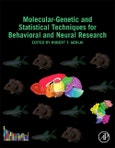Molecular-Genetic and Statistical Techniques for Behavioral and Neural Research presents the most exciting molecular and recombinant DNA techniques used in the analysis of brain function and behavior, a critical piece of the puzzle for clinicians, scientists, course instructors and advanced undergraduate and graduate students. Chapters examine neuroinformatics, genetic and neurobehavioral databases and data mining, also providing an analysis of natural genetic variation and principles and applications of forward (mutagenesis) and reverse genetics (gene targeting). In addition, the book discusses gene expression and its role in brain function and behavior, along with ethical issues in the use of animals in genetics testing.
Written and edited by leading international experts, this book provides a clear presentation of the frontiers of basic research as well as translationally relevant techniques that are used by neurobehavioral geneticists.
Please Note: This is an On Demand product, delivery may take up to 11 working days after payment has been received.
Table of Contents
Section I: Neuroinformatics, Computational Models and Data Analysis 1. Neurological Biomarkers and NeuroInformatics: The Role of The Virtual Brain 2. Informatics for Interoperability of Molecular-Genetic and Neurobehavioral Databases 3. The Allen Brain Atlas: Towards understanding brain behavior and function through data acquisition, visualization, analysis and integration 4. ExAtlas: On-line tool to integrate gene expression and gene set enrichment analyses 5. Computational Models: How do they help to understand neurological diseases? 6. The Use of Recombinant Inbred Strains in Systems Genetics and Functional Analyses in Behavioral Pharmacology Section II. Searching for New Genes: Natural Genetic Variation 7. Spontaneous versus induced mutations: Conceptual and methodological considerations for the neurobehavioral geneticist 8. Reduced complexity cross design for behavioral genetics 9. Collaborative Cross as the next-generation mouse genetic reference population designed for dissecting complex traits 10. Discovery of novel genes and other lineage-specific features through comparative genomics 11. Using signatures of directional selection to guide discovery Section III: Discovery of New Genes and New Functions of Genes Using Gene Expression Analyses 12. Using Transcriptomics to Study Behavior 13. Genes, Behavior and Next-Generation Sequencing The First Ten Years 14. Abnormal social behaviors and dysfunction of autism-related genes associated with daily agonistic interactions in mice 15. Epigenetic mechanisms of learning and memory Section IV: Discovery of Genes and Biological Mechanisms: Forward Genetics and Other Screening-Based Methods 16. Systematic screens in zebrafish shed light on cellular and molecular mechanisms of complex brain phenotypes 17. The transition of zebrafish functional genetics from random mutagenesis to targeted integration Section V: Manipulating Known Genes to Understand Biological Function: Reverse Genetics 18. Molecular Techniques Used to Explore Glutamate Receptors in Synaptic Plasticity and Memory 19. Using Herpes Simplex Virus Type-1-Based Amplicon Vectors for Neuroscience Research and Gene Therapy of Neurological Diseases 20. Cre-lox neurogenetics: history, present and future 21. Functional Analysis of Proteins Involved in Neurodegeneration Using the Model Organism Dictyostelium: Alzheimer's, Huntington's and Batten Disease 22. The role of human endogenous retroviruses (HERVs) in the pathologies of nervous system 23. Optogenetics dissection of sleep circuits and functions 24. The use of DREADDs for dissecting the contribution of cellular and neural circuit mechanisms in models of neurodegenerative disease Section VI: Ethical Considerations 25. Genes and human behavior: Ethical implications 26. Ethical Considerations for Animal use in Behavioral and Neural Research
Authors
Robert T. Gerlai Department of Psychology, University of Toronto Mississauga, Mississauga, Ontario, Canada. Dr. Gerlai received his Ph.D. from the Hungarian Academy of Sciences with the highest distinction in 1989. He has held numerous academic positions in Europe and North America (Eötvös University of Budapest, Mount Sinai Hospital Research Institute of Toronto, Indiana University Purdue University Indianapolis, University of Hawaii Honolulu), and he also held leadership positions in the US biotechnology and biopharmaceutical research industry working as a senior research scientist and Vice President (Genentech Inc. South San Francisco, Eli Lilly & Co. Indianapolis, Saegis Pharma Half Moon Bay) before joining the University of Toronto in 2004, where he is currently full professor at the Department of Psychology.Dr. Gerlai has published over 200 papers in peer reviewed scientific journals and books with a cumulative citation number over 12000 and an H index of 55. He is member of editorial boards of PLOS ONE, Learning and Behavior, Genes Brain and Behaviour, Neurotoxicology and Teratology. He is Associate Editor of Frontiers in Genetics of Complex Traits, Review Editor for Frontiers in Neuroscience and Section Editor for BioMedCentral Neuroscience. He has edited several special issues of scientific journals and served as co-editor of handbooks on molecular genetic approaches in behavioural neuroscience. He is founding member of the International Behavioral and Neural Genetics Society, IBANGS. He was the president of the International Behavioral Neuroscience Society (IBNS) in 2007 and 2008, and he has been elected Fellow of this Society since 2005. He received the Distinguished Scientist Award from IBANGS in 2013 and the John Wiley Distinguished Speaker Award from the International Society of Developmental Psychobiology in 2014. In 2015, he was awarded the University of Toronto Mississauga Excellence in Research Award.
Dr. Gerlai's research focusses on the biological and genetic mechanisms of behaviour. For the past fourteen years his research at University of Toronto has been using zebrafish employing behavioural phenotyping, psychopharmacological and genetic methods to study mechanisms of alcohol abuse, fetal alcohol spectrum disorders, and of learning and memory. His laboratory has been funded by NIH, NSERC and Brain Canada.








